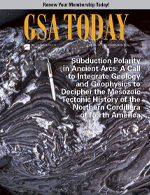Full Text View
Volume 29 Issue 11 (November 2019)
GSA Today
Article, pp. 4-10 | Full Text | PDF
Subduction Polarity in Ancient Arcs: A Call to Integrate Geology and Geophysics to Decipher the Mesozoic Tectonic History of the Northern Cordillera of North America
Cover Image
Search Google Scholar for
Search GSA Today
Abstract
Recent syntheses of Cordillera tectonics contain contradictory views of subduction polarity in the late Mesozoic, and this contradiction has implications for whole-earth processes. The long-held view of east-dipping subduction throughout the Late Jurassic–Early Cretaceous Cordillera is challenged by tectonic models calling on a west-dipping subduction system that led to the collision of oceanic arcs, ribbon-continents, or both, with North America. Evidence in support of these models are seismic anomalies in the deep mantle inferred to represent subducted lithosphere from a west-dipping slab. We argue that this “bottom-up” approach to tectonic synthesis carries assumptions that are as great as or greater than ambiguities from the “top-down” approach of surface geology. Geologic evidence from the northern Cordillera is inconsistent with west-dipping subduction in Jura-Cretaceous time and requires long-lived east-dipping subduction along much of the Cordilleran margin. West-dipping subduction in Triassic–Early Jurassic time has been documented and may be the source of the seismic anomalies. We encourage the broader community to come to consensus on integration of these deep images with surface geology.
Manuscript received 19 Feb. 2019. Revised manuscript received 1 May 2019. Manuscript accepted 5 May 2019. Posted 5 June 2019.
© The Geological Society of America, 2019. CC-BY-NC.

